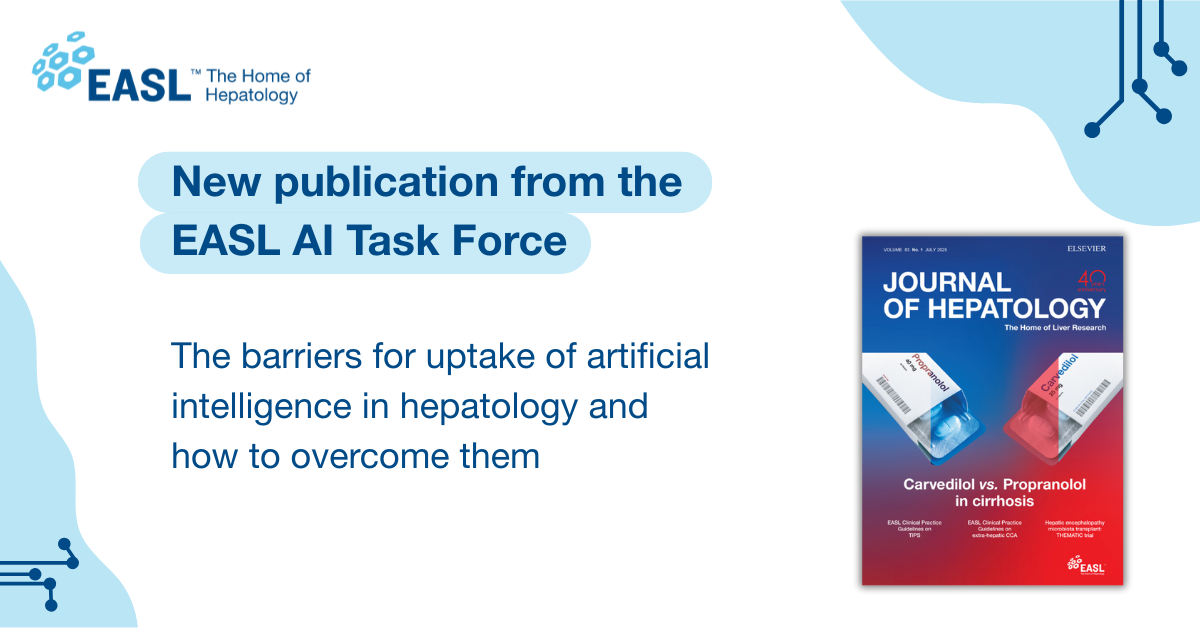New publication from the EASL AI Task Force

Overcoming Barriers, Seizing Opportunities:
Expert Recommendations for the Use of AI in the Diagnosis, Treatment, and Research of Liver Diseases
This paper is more than a review: it is a consensus report by a group of 34 leading international experts in hepatology, data science, and artificial intelligence, presenting concrete recommendations for the clinical application of AI in hepatology.
What is unique about this publication is the international, interdisciplinary consensus – the result of close collaboration between experts from different countries and disciplines. This common basis can help us to translate pioneering AI technologies from the lab into clinical practice. We illustrate this roadmap for hepatology, but our goal was to develop a scalable blueprint also for other areas of medicine as they face similar challenges.
Dr Jan Clusmann
Framework and focus of consensus
The availability and accessibility of artificial intelligence (AI) has drastically increased in recent years. However, despite some achieving regulatory approval, they are seldom used in routine practice.
Reluctance to adopt AI in clinical practice stems from several key challenges. Complex jargon and unfamiliar technology can erode trust among healthcare professionals. Many tools lack alignment with real world needs, making integration difficult, while limited, low quality datasets reduce model reliability. In addition, most AI applications are narrow in scope, failing to support the multimodal reasoning essential in clinical decision-making. Based on this consensus, three key areas need to be addressed to advance adoption: proving clinical efficacy and trustworthiness, reducing practical barriers, and building supportive implementation frameworks.
The term AI encompasses several tools that can be used at different stages of clinical care, from early disease detection to treatment planning and outcome predication. To guide AI adoption in hepatology, this Expert Opinion presents 22 active recommendation statements rated by 34 experts in the fields of hepatology, shared data, clinical AI and regulation. These recommendations span 5 different domains, addressing the challenges and opportunities surrounding AI integration in clinical practice.
Translating AI into clinical practice: What’s needed?
Although AI tools are increasingly available in hepatology, their use in clinical practice remains limited. Regarding this aspect, the main recommendation that emerges from the report is the importance of AI proficiency within the medical community. As mentioned before, the panel highlighted three essential domains that must be addressed to support broad and impactful clinical implementation of AI in hepatology. Firstly, AI tools must demonstrate clinical efficacy and trustworthiness. Secondly, they must lower practical barriers by integrating intuitively and seamlessly into clinicians’ daily workflows and hospital-information-systems. Finally, they must create incentives and implement frameworks, such as being integrated into dedicated sections of the clinical practice guidelines. Tackling these implementation barriers is key to facilitating regular use of AI systems in the future. Other major challenges and limitations including decisional responsibility, cybersecurity, software long-term pricing models, lack of interoperability and environmental sustainability are thoroughly addressed in the article.
AI has the potential to transform the care and study of liver diseases. However, we are still facing significant implementation barriers. Our publication aims to provide clear guidance on how to overcome these and move toward routine clinical use of AI-based systems.
Prof. Jakob N. Kather
What can professional institutions and societies do?
The authors outline several actionable items aimed at providing societies with practical solutions to help transform medical care with AI. Societies are encouraged to establish shared databases and support independent, multi-centre validation studies. According to the panel, bridging the gap between AI researchers and clinical trial investigators is a critical factor for the successful of adoption of AI in clinical practice. This may be done through collaborative planning sessions where both groups jointly design trial protocols that integrate AI components, and by offering targeted training programmes to include clinicians in the development of AI solutions. Additionally, the consensus panel agreed that guidelines should serve as prioritised, evidence-based frameworks for AI models, and include dedicated sections addressing state-of-the-art AI models relevant to the specific field.
At EASL, we are well placed to support the education of clinicians on the fundamentals and potential applications of AI. We can help foster connections between AI researchers, clinical trial developers, and policymakers, and contribute to a shared understanding of how AI might enhance patient care. By recommending validated tools in our guidelines and supporting the development of central, unbiased data repositories, we can play a constructive role in advancing trustworthy and effective AI in hepatology.
Dr Sabela Lens García
Moving forwards
From the need for high-quality, multimodal data to the importance of aligning tools with clinical workflows, this Expert Opinion outlines actionable recommendations across five key domains, emphasising the importance of collaboration among AI developers, clinicians, and regulators. Bridging these gaps will be crucial to unlocking the full potential of AI in hepatology and beyond.

